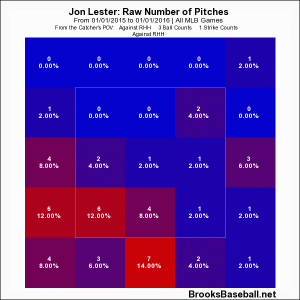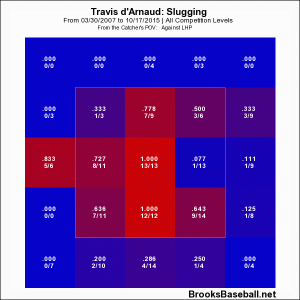In Game Six of the 2013 World Series, after Shane Victorino lined a 2-1 four-seam fastball from Michael Wacha off the Green Monster for a bases-clearing, series-clinching double, Tim McCarver made the following observation: “When you fall behind, your pitches become predictable.” As he said this, the broadcast showed the replay of Wacha’s knee-high 94-mph fastball right over over the middle of the plate.
In Game One of the NLCS on Saturday, Jon Lester found himself in a similar situation when facing Travis d’Arnaud with two outs in the sixth inning.
Travis d’ Arnaud has mashed left-handed pitching both in 2015 (.333/.423/.689), and has been above league average in his career (.244/.317/.440). He did not play in either of Lester’s starts against the Mets this season, but in his career against the five pitches in Lester’s repetoire, he has been successful against cutters, curves, and changeups from left-handed pitchers, while struggling against four-seam fastballs and sinkers:
| Pitch | % of pitches from LHP | SLP | HR |
| Fourseam | 32.8% | .353 | 2 |
| Cutter | 5.5% | .685 | 0 |
| Sinker | 26.4% | .200 | 4 |
| Curve | 6.5% | .429 | 0 |
| Change | 19.2% | .548 | 2 |
Lester started d’Arnaud with a four-seam fastball over the plate for a called strike one. d’Arnaud then took three straight balls—two pitches low and off the plate and a borderline pitch on the outside corner. Ahead 3-1, d’Arnaud was in the driver’s seat against a pitcher, who, as you will see below, goes to fastballs overwhelmingly in these situations.
How did Lester and d’Arnaud perform this season once the count reached 3-1?
Lester on 3-and-1 this season…
.333/.613/.444, 1 HR
This season, when Lester got to 3-1 against right-handed batters, he threw fastballs 90 percent of the time (32 percent fourseam, 38 percent cutter, 20 percent sinker). Overall, he went with fastballs 93 percent of 3-1 counts. Against right-handed batters, he pounded the strike zone low and inside:
When Lester falls behind left-handed batters, he goes to his fastballs with 94 percent frequency (56 percent fourseam , 32 percent cutter, 6 percent sinker), making him extremely predictable.
d’ Arnaud on 3-and-1 this season…
.333/.750/.833, 1 HR
As you can see below, left-handed pitchers have few safe areas in the strike zone against d’Arnaud:
After coming over the plate on the first pitch, Lester stayed away the next three pitches. Would Lester and Ross again attempt to get d’Arnaud, who swung at just 28.1 percent pitches outside of the strike zone this season, to chase a pitch, or would they have no choice to come over the plate?
The Pitch
On 3-1, Ross set up knee high on the outer half of the plate, but the pitch—an 89-mph fastball—came back over the plate and stayed up slightly. Unlike the majority of 3-1 counts against right-handers this season, Lester and Ross attempted to stay away from d’Arnaud.
d’Arnaud had a short load, lifting his front foot slightly, and got the barrel head on the baseball, launching the pitch into the frigid Queens night, a 436-foot shot off the apple in the center-field bleachers. The Mets led 3-1, and it would prove to be the winning run, as they would go on to win 4-2.
Lester got himself in a bad situation. In 2015, when behind 3-1, he became predictable and fastball dependent (93 percent usage in 3-1 counts). This season, d’Arnaud destroyed left-handed pitchers, posted a 1.583 OPS in 3-1 counts, and hammered left-handed pitchers in the middle of the strike zone. It was a dangerous confluence of events.
Lester was not at his sharpest in Game One. In David Ross’s postgame comments, he confirmed that observation and added that Lester did not have his cutter, his most effective and consistent pitch after the All-Star break. Against d’Arnaud, Lester missed his spot slightly with a fastball over the plate and in d’Arnaud’s power zone, and the result was the game-winning run. As Tim McCarver prophesizes, it shall come to pass.
Lead photo courtesy of Anthony Gruppuso-USA TODAY Sports


